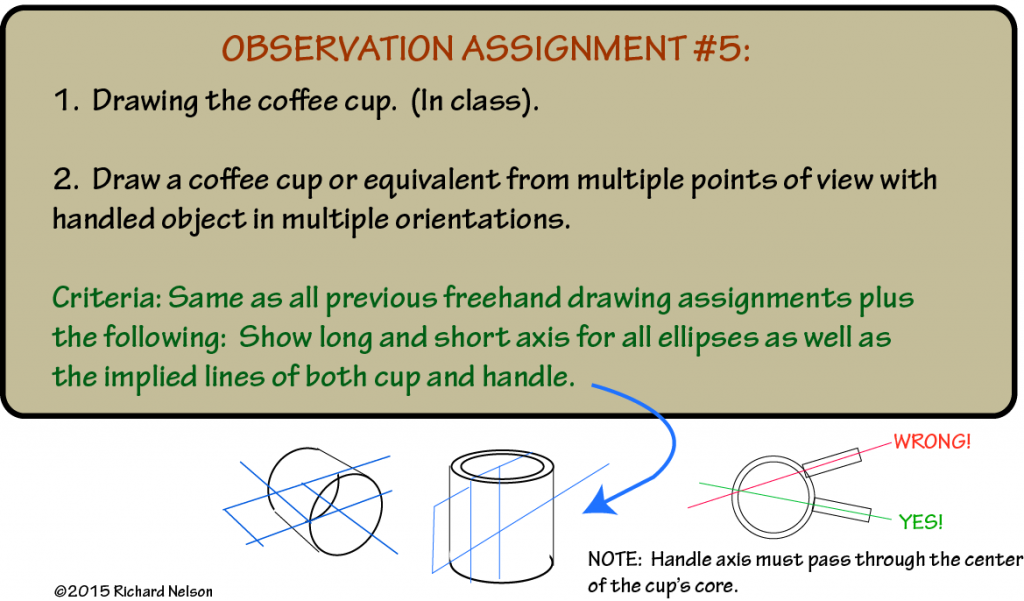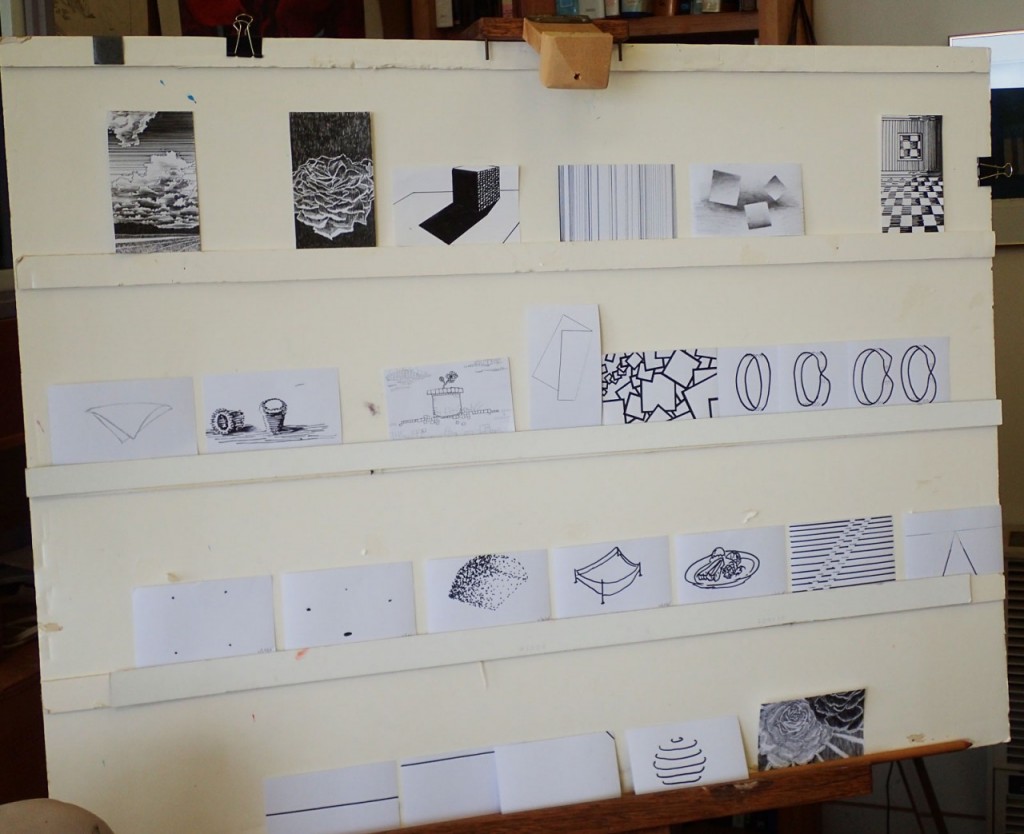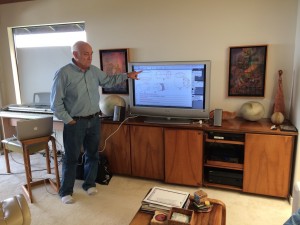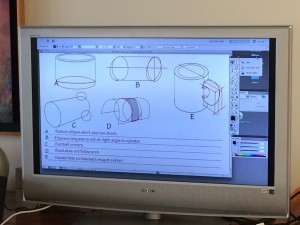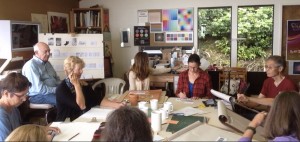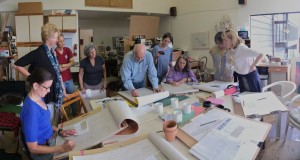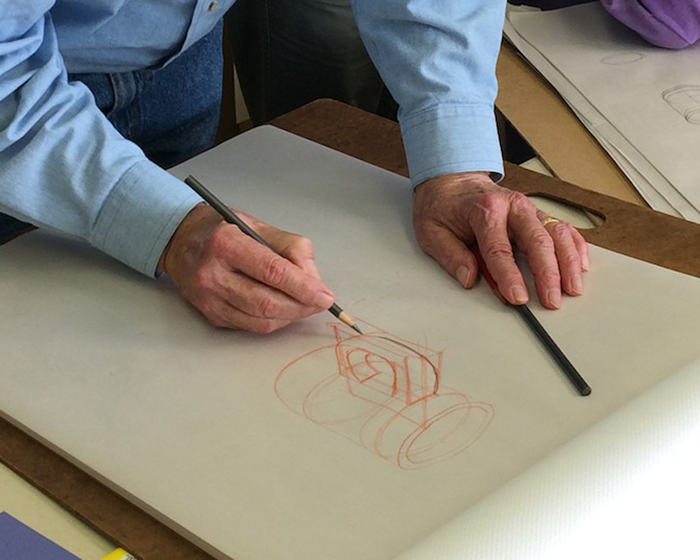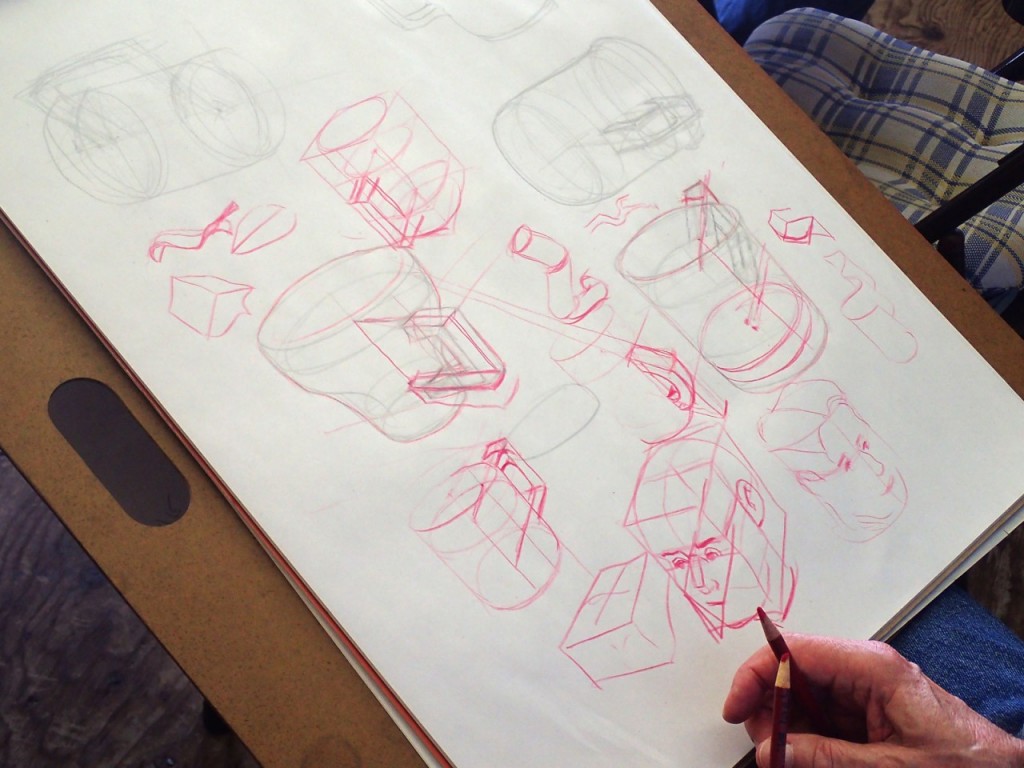The fifth session of the Drawing Foundation class for Fall 2015 was held on Thursday, October 15. The class critiqued their results from the previous assignment; shared this week’s index card solutions; and practiced drawing coffee mugs, a step up in the complexity of forms. Learning to recognize the invisible forms that shape an object is an important skill to have if you want to draw images that are ‘true to life’.
Homework assignment
The new observation assignment is below. Continue with index card assignments and linear perspective DVD assignments as well.
Class recap – some key ideas
Insights and challenges from the last assignment
We began the class by asking what people’s experiences were with the last assignment of drawing flowerpots and cylinders in perspective. Most people found it very challenging, especially getting the correct shapes and sizes for ellipses that are ‘standing up’ (for example, a flowerpot lying on its side). Even getting the right length and shape for the base of the flowerpot proved difficult, so Dick held up a small flowerpot and asked us to see where the side of the pot met the top. It turns out the line delineating the side of the pot went straight to the outer edge of the top, which most of us had missed.
This was another tip for drawing objects in correct proportion and perspective: always draw your lines past the point of their physical appearance (draw the invisible lines and forms that surround them). If you can find where the lines of perspective go, and the planes of intersecting shapes, you can fit the visible forms into proper positions.
Blind contour drawing
Dick briefly made mention of the book Drawing on the Right Side of the Brain, by Betty Edwards, which we will be discussing in upcoming sessions. One of the exercises is ‘blind contour drawing’, a technique that is designed to purposely slow us down and teach us to connect our eyes to our hands. The method is deceptively simple (to draw an object or figure using a single continuous line, and without looking at the paper), yet profound in its challenges. This ‘blind’ practice forces us to slow down our drawing process, and to truly observe what we are drawing rather than rush through it and make perceptual mistakes. By deliberately using both our eyes and our hands at a measured pace, we begin to see the lines of a shape rather than a named object; instead of seeing ‘a flowerpot’, we see the angles and curves of a line.
Dick had us try this technique for about five minutes, drawing just the bottom part of a flowerpot, proving that the top or bottom of a cylinder is subtly curved rather than pinched at the edges. So now there is no excuse: no more ‘football corners’!
Index card drawings
We briefly touched on this week’s index cards, which are growing in complexity and detail. Leonard had some great illustrations of a Möbius strip, which is composed of parallel lines that twist over each other but never actually touch (tricky!). Susan tried her hand at perspective within perspective, by drawing a room with a checkered floor pattern, and a mirror hanging on a wall reflecting the floor pattern. She said she made several attempts while practicing how to draw the multiple perspectives, and all done with parallel lines: quite a leap from the first week of class!
All in all, students are still discovering new avenues in which to meet the criteria, and ever more creative ways to use the restrictions of this assignment to explore some advanced concepts.
Susan also shared a revelation she had had earlier in the day that demonstrated how much this course had already had a change in her perception of the visual world. While waiting in line at a bakery, she had pulled out her sketchbook to do a quick drawing of the scene outside. She was amazed at how easily she was able to recognize the angles and implied lines of the buildings and foliage, and how pleasant it was to confidently sketch out a scene that in the past would have been more confusing and disorganized. She was thrilled to find that these lessons are already having an impact in her daily life.
Worksheet with faulty drawings
After that, the class broke into several small groups to tackle the worksheet for the day, which included critiquing the last homework assignment, and identifying mistakes in a number of incorrect drawings. It is another skill to learn how to correctly recognize aspects of drawings that seem ‘off’, and how they should be altered so as to match true perspective.
We went over the answers as a group, with Dick sharing an answer sheet that had the corrections in red. This visual identification is an important skill to develop, as it will help you critique your own drawings and make the proper corrections as needed.
- Dick sharing the answers to the faulty images
- Corrections shown in red
Slide show of creative projects
Dick then surprised us with a slideshow of images he had pulled from the Internet, of creative projects around the world. Most of the images were of sculptures, and one common theme was playing with size or proportion: objects seen as larger or smaller than normal have a way of jolting our preconceptions.
The content was in turns playful and creepy, with some of the work being a bit more macabre than others! But all of them exhibited a level of craftsmanship and ingenuity that made the final result breathtaking, whether or not one personally enjoyed the subject matter.
Drawing cups with handles
After our coffee break, we moved on to the next drawing assignment: a coffee mug! Once again, a simple everyday object becomes surprisingly challenging when attempting to draw it in correct perspective.
- Observation drawing in class: Drawing coffee cups at different orientations
- Demonstrating how to draw a cup with a handle
One of the key skills in drawing objects or people is to recognize the basic shapes that define the subject. For example, a coffee mug is made up of a cylinder, with one end open and the other end closed off; and the handle that attaches to the outside of the cylinder is an arch that fits inside a basic rectangle.
If you can learn to identify the most basic forms that shape an object, then you will have a much easier time drawing subjects in correct proportion, and with proper volume.
To show us how this translates into a portrait, Dick demonstrated how to draw a head. The human head fits into a cube shape, while the nose is like a handle on a cup: a rectangle that intersects the mid-line of the cube. By drawing in the most simplified shapes first, you can find your placement and arrangement of shapes before filling in the details that create the unique subject matter.
Video demos
Cup Handle (6 minutes): Dick Nelson illustrates how construction lines aid accuracy in creating a perspective drawing of a handled object such as a coffee cup.
Cup Handle, Head (14 minutes): Dick Nelson shows how being able to visualize the bounding box and intersecting planes allows one to apply the same principles of a handle attaching to a cup to how a nose fits on a face, and drawing not just what you see, but what you imagine.
Class materials
[gview file=”https://dicknelsoncolor.com/wp-content/uploads/2015/10/FlwrPotCupConst.pdf”]
